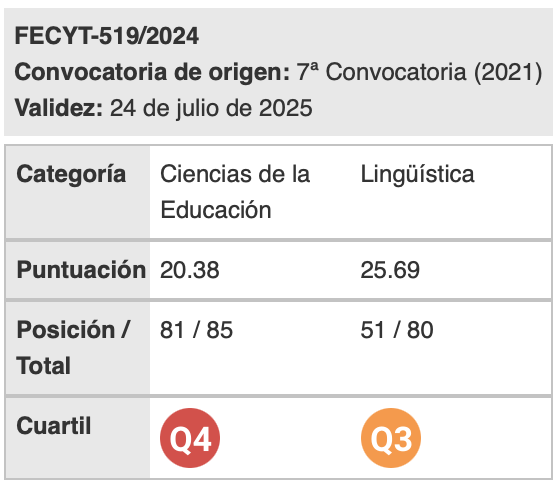Public Service Announcements to promote integration of People with Down Syndrome: a synchronic analysis
Palabras clave:
languagues for specific purposesResumen
The aim of this paper is to undertake a study on advertisements released on youtube concerning integration of people with Down Syndrome. This study will be based on the different elements included (visual, audio and dialogues) in the advertisements done in Spain and United States in the year 2018 commemorating the international day.
As everybody knows, developed countries have as one of their social objectives to promote tolerance and acceptance of the different minority groups no matter the condition: race, genre, sexual orientation, different capacities or so. This is an aim that should be recognised in every country to be considered developed and forward-looking thinking. In order to perform this, associations and organisms try to attract the attention of the citizens through advertisements in which sameness and equality is the main message. To do this, language and images play a decisive role. But these videos are not considered advertisements as such as their aim is social and not mercantilist. So, features will vary. We shall analyse these resources and conclude with the degree of efficacy.
Descargas
Citas
Aijmer, K. (ed.) (2004). Discourse Pattern in Spoken and Written Corpora Amsterdam: John Benjamins.
Berger, J.A. and Milkman, K.L. (2009). “What makes online content viral?”, working paper series SSRN, available at: http://ssrn.com/abstract¼1528077; http://dx.doi.org/10.2139/ssrn.1528077 (accessed July 10, 2012).
Berrocal, S., Domínguez, E. C., & García, M. R. (2012). “El «infoentretenimiento» en Internet. Un análisis del tratamiento político de José Luis Rodríguez Zapatero, Mariano Rajoy, Gaspar Llamazares y Rosa Diez en YouTube”, Doxa Comunicación: revista interdisciplinar de estudios de comunicación y ciencias sociales, (15), 13-34.
Biber, D. (1988). Variation across Speech and Writing Cambridge University Press.
Boitor, B., et al. "Impact of New Online Ways of Advertising." Bulletin of the Transilvania University of Brasov.Economic Sciences.Series V 4.2 (2011): 11-8. Print.
Brown, G. & G. Yule (1986). Discourse Analysis Cambridge University Press.
Collin, W. (2008) in Lannon, J (ed.) How Public Service Advertising Works World Advertising Research Center.
Cook, G. (1992). The Discourse of Advertising London: Routledge.
Duboviciene, T & P. Skorupa “Linguistic characteristics of commercial and social advertising slogans” Coactivity: Philology, Educology 23.2 (2015): 108-118.
Duranti, A. “Samoan Speechmaking across Social Events: one genre in and out of a fono.” Language in Society 12.1 (1983): 1-22.
Fuhrel-Forbis, A., P. Gayle Nardoff & L. Snyder “Analysis of Public Service Annoncements on National Television, 2001-2006” Social Marketing Quarterly 15.1 (2011): 49-69.
Gladwell, M. (2002). The Tipping Point: How Little Things Can Make a Big Difference Boston: Back Bay Books.
Kaplan, A.M. and Haenlein, M. “Users of the world, unite! The challenges and
opportunities of social media”, Business Horizons, 53.1 (2010): 59-68.
Khan, G. F., and S. Vong. "Virality Over YouTube: An Empirical Analysis." Internet Research 24.5 (2014): 629-47. Print.
Labrador, B., N. Ramón, H. Alaiz-Moreton & H. Sanjurjo-Gonzalez. “Rhetorical Struture andd Persuasive Language in the Subgenre of Online Advertisements” English for Specific Purposes 34 (2014): 38-47.
McCarthy, M. (1998). Spoken Langauge and Applied Lingusitics Cambridge University Press.
Paek, H., T. Hove & H. J. Jeong (2011) “Peer or Expert? The persuasive Impact of YouTube Public Service Announcement Producers” International Journal of Advertising 30.1 (2011): 161- 188.
Porter, L. and Golan, G.J. “From subservient chickens to brawny men: a comparison of viral advertising to television advertising”, Journal of Interactive Advertising, 6.2 (2006): 30-38.
Pousttchi, K. and D. G. Wiedemann. (2007), “Success factors in mobile viral marketing: a multi-case study approach”, paper presented at the Management of Mobile Business, ICMB 2007, International Conference, July 9-11.
Rowse, E. J., Fish, L. J. (2005). Fundamentals of Advertising. USA: Kassinger Publishing.
Sádaba, I., & Rendueles, C. (2016). “Metodologías de análisis del espacio audiovisual online: Entre la innovación y la ansiedad de la novedad/Methodologies for the analysis of online audiovisual space: Between innovation and anxiety of novelty”. Empiria, (35), 105.
Schlosser, A.E., S. Shavitt & A. Kanfer “Survey of internet users’attitudes toward internet advertising” Journal of Interactive Marketing 3.13 (1999): 34-54.
Storey, R. (2008) in Lannon, J (ed.) How Public Service Advertising Works World Advertising Research Center.
Trehan, Mukesh and Ranju Trehan. Advertising and Sales Management. 2nd ed. Delhi: Prince Print Process, 2006. Print.
Tuten, T. L. (2008). Advertising 2.0 Social Media Marketing in a Web 2.0 World London: Praeger
Williams, D., S. J. Sullivan, A. G. Schneiders, O. H. Ahmed, H. Lee, A. P. Balasundaram & P. R. McCrory “Big Hits on the Small Screen: an Evaluation of Concussion-Related Videos on Youtube”. British Journal of Sports Medicine, 48.2 (2014): 107-111.
Yang, K. C. et al. “Consumer attitudes towards Online Video Advertisement: Youtube as a Platform.” Kybernetes 46.5 (2017): 840-53.
Descargas
Publicado
Cómo citar
Número
Sección
Licencia
Aquellos autores/as que tengan publicaciones con esta revista, aceptan los términos siguientes:
- Los autores/as conservarán sus derechos de autor y garantizarán a la revista el derecho de primera publicación de su obra, el cuál estará simultáneamente sujeto a la Licencia de reconocimiento de Creative Commons que permite a terceros compartir la obra siempre que se indique su autor y su primera publicación esta revista.
- Los autores/as podrán adoptar otros acuerdos de licencia no exclusiva de distribución de la versión de la obra publicada (p. ej.: depositarla en un archivo telemático institucional o publicarla en un volumen monográfico) siempre que se indique la publicación inicial en esta revista.
- Se permite y recomienda a los autores/as difundir su obra a través de Internet (p. ej.: en archivos telemáticos institucionales o en su página web) antes y durante el proceso de envío, lo cual puede producir intercambios interesantes y aumentar las citas de la obra publicada. (Véase El efecto del acceso abierto).

Revista de Lenguas para fines específicos is licensed under a Creative Commons Reconocimiento-NoComercial-SinObraDerivada 4.0 Internacional License.























